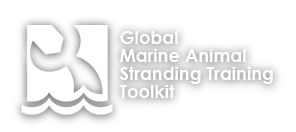Distilled list of Training objectives

Whale necropsy at Chatham Light Beach Source: IFAW
The focus of this phase of the marine mammal stranding response toolkit is primarily, response to small cetaceans and pinnipeds for the core responder or trainer. Live Small Cetacean Response (small cetaceans include bottlenose dolphin, rough-toothed dolphin, spinner dolphins, spotted dolphins excluding pilot whales, which require a different approach). Below we provide an outline of the key training objectives for responding to live/dead small cetaceans and pinnipeds and elements within each objective, which are covered in-depth in the training modules.
List of Training Objectives for Live Small Cetacean:
- Maximize human safety during stranding response.
- Maximize animal safety during stranding response.
- Accurately receive and record a call or report of a stranded marine mammal.
- Assess the stranding scene upon arrival.
- Human safety
- Animal safety
- Species ID
- Behavioral observations
- Individual animal ID
- Initial photos
- Determine accessibility
- Information dissemination
- Provide supportive care to stranded cetaceans to increase the likelihood of survival and improve welfare during stranding.
- Human safety
- Protection from the environment
- Righting the animal
- Protection from predators
- Assist experienced responders in completing a health assessment for each individual animal.
- Human safety
- Monitoring vital parameters
- Observing behavior/activity
- Take basic morphometrics
- Determine approximate age class
- Assess nutritional condition/body condition
- Assess for evidence of Human Interaction
- Assist in determining the optimal disposition for each animal.
- Assist experienced responders in the collection of samples from live animals.
- Human safety
- Equipment
- Blood samples
- Assist experienced responders in stretchering, transport, and disposition
- Human safety
- Stretchering
- Supportive care
- Understand the basic principles of data recording. Record data accurately throughout a stranding event.
- Document the stranding scene, event, and individual animals with images.
Training Objectives for Live Pinniped
Note: Step I to IV same as live small cetacean
- Assist experienced responders in completing an initial assessment for each individual animal.
- Human safety
- Monitoring vital parameters
- Determine approximate age class
- Assess nutritional condition/body condition
- Assist in determining the optimal disposition for each animal.
- Assist in determining the optimal disposition for each animal.
- Assist experienced responders in rescue and containment of the animal.
- Human safety
- Equipment
- Rescue techniques
- Assist experienced responders in animal transport.
- Understand the basic principles of data recording and record data accurately throughout a stranding event.
- Document the stranding scene, event, and individual animals with images.
Training Objectives for Dead Small Cetacean and Dead Pinniped
- Maximize human safety during stranding response.
- Accurately receive and record a call or report of a stranded marine mammal.
- Assess the stranding scene upon arrival.
- Human safety
- Species ID
- Initial photos
- Determine accessibility
- Information dissemination
- Assist experienced responders in completing an initial examination for each individual animal.
- Human safety
- Determine approximate age class
- Assess nutritional condition/body condition
- Human interaction
- Document appropriate morphometrics.
- Equipment
- Assist experienced responders in sample collection.
- Understand the basic principles of data recording. Record data accurately throughout a stranding event.
- Document the stranding scene, event, and individual animals with images.
- Assist in determining the optimal disposition for each animal.
